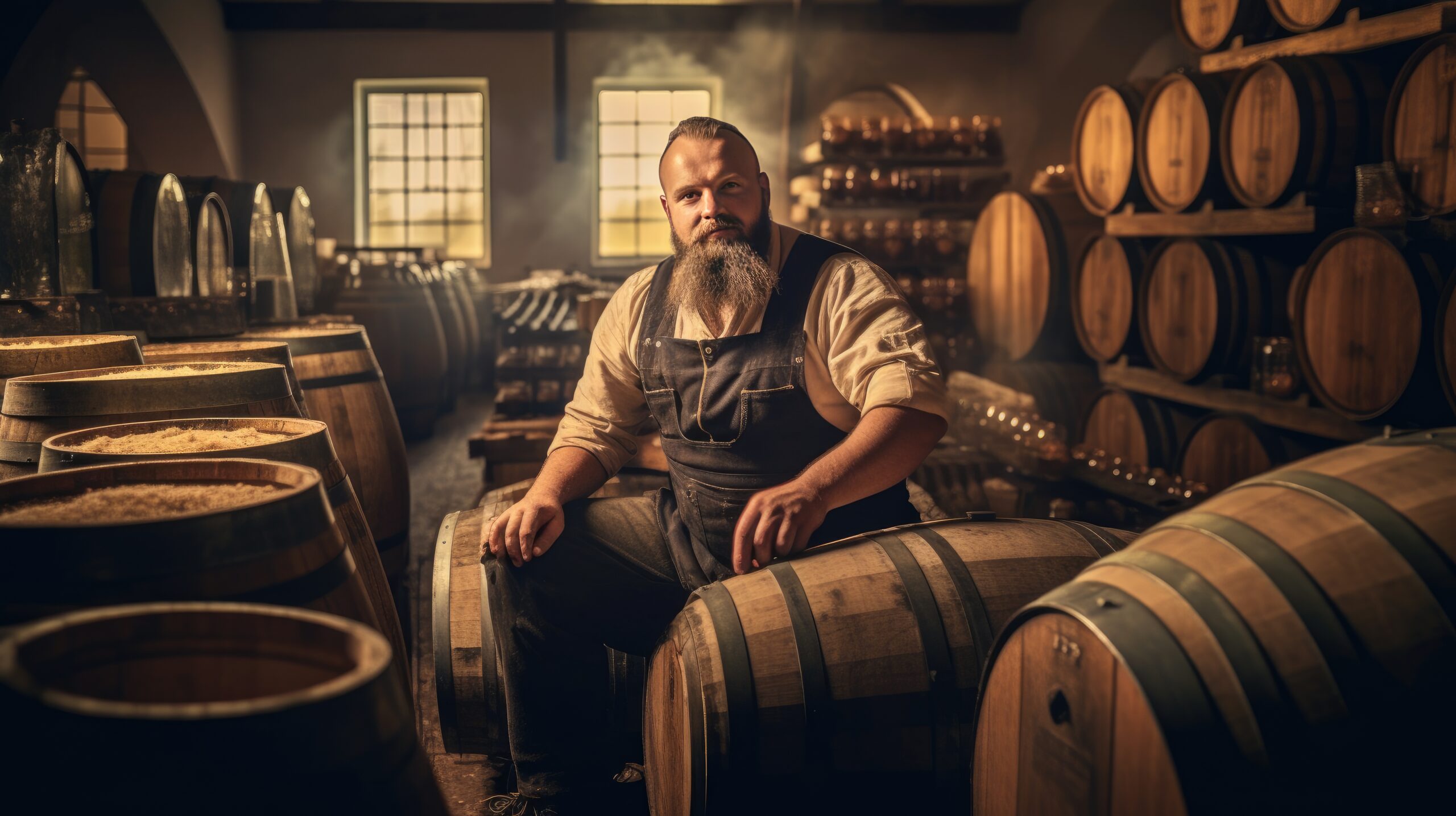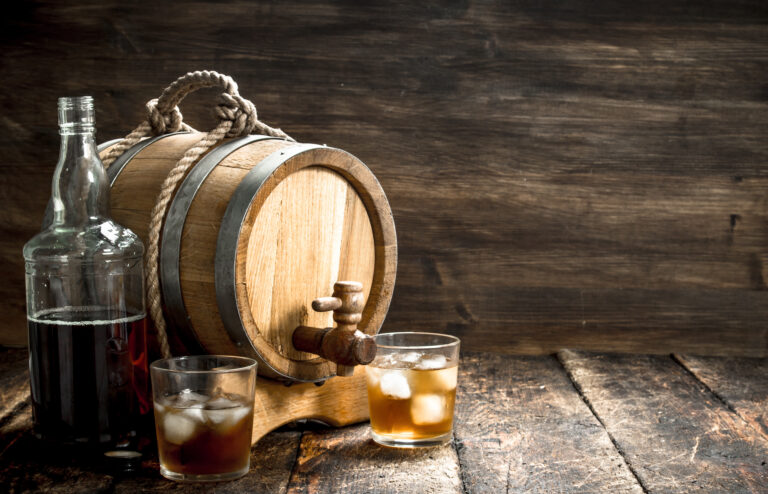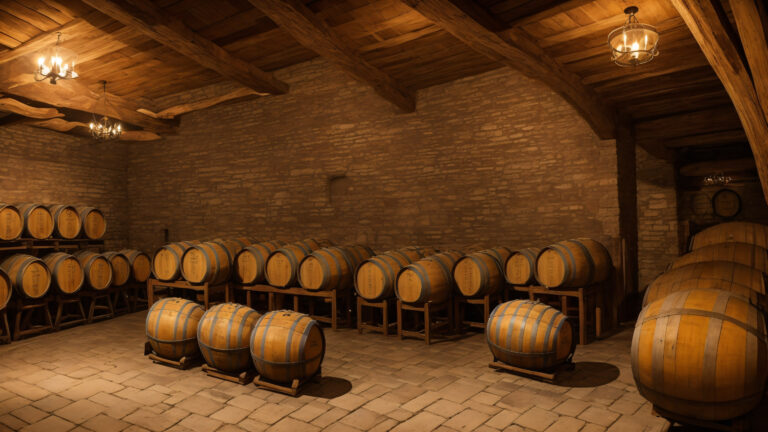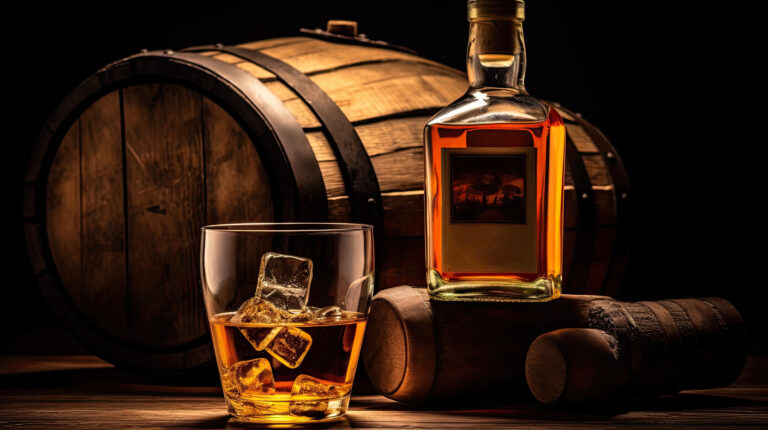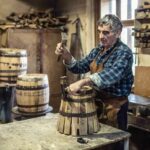You cherish your whiskey neat or on the rocks, but have you ever pondered how distillers achieve that distinct and utterly consistent flavor profile? The true artistry of barrel blending holds the key. Once distilled, whiskey embarks on its journey, maturing in charred oak barrels. But here’s the kicker: even barrels crafted from the very same type of oak can impart surprisingly different nuances to the whiskey. That’s why master distillers meticulously sample and blend whiskeys from various barrels, crafting the unmistakable, signature taste of their brand.
It’s not merely about combining whiskeys of the same age. Master blenders skillfully intertwine younger, more vibrant whiskeys with older, mellower ones to strike that perfect flavor balance. They also artfully blend whiskeys aged in barrels with varying levels of char, aiming to introduce delightful notes of vanilla, caramel, and spice. The ultimate goal? To achieve that perfect harmony of aroma and taste that whiskey connoisseurs have come to anticipate and adore.
Through the true alchemy of barrel blending, distillers are able to consistently produce batch after batch of premium whiskey with a taste as unique as your own fingerprint. The next time you raise a glass of your favorite whiskey, perhaps a bourbon or a single malt, take a moment to salute the blenders who made it all possible. Their craftsmanship truly is an art form.
An Introduction to Barrel Blending for Whiskey Consistency
Barrel blending is an art form that master distillers employ to create remarkably consistent and delightful flavors in whiskey. By mingling spirits from different oak barrels, they can produce a harmonious and complex taste that whiskey consumers consistently expect and cherish. This meticulous process ensures brand consistency.
The Aging Process
Oak barrels are fundamental in giving whiskey its distinctive flavor and aroma compounds as it ages. However, a crucial aspect to remember is that no two barrels will ever produce precisely the same result, even if filled with the identical spirit from the same distillation run. Each whiskey barrel imparts its own unique fingerprint on the liquid within, a testament to the natural variations of wood and aging conditions.
Choosing the Right Barrels
The type of barrel, its char level (the degree of burning inside the barrel), and the number of times it’s been used — often referred to as its “seasoning” — all profoundly impact the spirit. New charred oak barrels typically yield bolder flavors, often with pronounced vanilla and caramel notes, compared to previously used barrels. The master distiller must carefully select barrels that will complement each other, contributing to the desired flavor profile of the whiskey expression.
Sampling and Blending
Master distillers consistently sample from various barrels to gauge how the spirits are developing. When a batch is nearing maturity, they meticulously mix small amounts from select barrels to create a target flavor profile. It’s not uncommon for them to combine the contents of over 50 individual whiskey barrels to achieve that perfect blend. This is a truly laborious process that relies entirely on refined human senses — sight, smell, and, of course, taste.
Achieving Consistency
The paramount goal is to create a blend that tastes remarkably similar from batch to batch. Only through diligent barrel management, frequent sampling, and relying on years of invaluable experience can distillers achieve a consistent product that becomes synonymous with their whiskey brand. The delicate art of barrel blending ultimately bestows premium whiskey its distinctive and memorable flavor.
The Importance of Consistency in Whiskey Production
To achieve unparalleled consistency in whiskey, distillers painstakingly blend barrels to create a balanced flavor profile that remains true from batch to batch. As whiskey matures, each oak barrel develops unique characteristics based on the barrel’s wood type, its age, and even its storage location within the rickhouse. This careful management is crucial for quality control.
The Art of Barrel Blending
Blending whiskey barrels is a craft that demands an expert palate and many years of experience. Distillers sample barrels and keenly analyze how flavors have evolved over time, noting qualities like sweetness, smokiness, and spice. They then meticulously blend barrels together in small batches, fine-tuning the amounts from each barrel until they achieve the desired consistent taste for that particular whiskey expression.
It’s certainly not an exact science. Distillers must account for natural variations in the barrels and the base spirits to create a whiskey that is reminiscent of previous releases, yet still possesses its own subtle uniqueness. The hallmark of a truly great distiller is their uncanny ability to consistently create a spirit that whiskey aficionados can enjoy time and time again.
Consistency doesn’t mean the whiskey will taste exactly the same from batch to batch, but rather that it exhibits the same general flavor profile, quality, and overall experience. There may be subtle differences that lend each release its own character, but at the end of the day, you can confidently count on that pour of your favorite whiskey to deliver familiar aromas and tastes. The careful selection of oak barrels and the precise blending process are equally important for crafting a truly memorable, world-class whiskey. Next time you swirl a glass of whiskey, raise a toast to the master distillers and blenders behind the scenes. Their skill and artistry are truly in every sip.
How Barrels Impact Whiskey Flavor Development
The oak barrels used to age whiskey exert an enormous influence on its final flavor. As whiskey matures in the barrel, it absorbs a myriad of flavors and aromas from the wood, such as delightful notes of vanilla and caramel. The specific type of barrel, how often it’s been used, and even where it’s stored within the warehouse all determine the extent of the barrel’s influence on the final spirit.
Barrel Type and Wood Influence
The most common types of barrels are American oak and charred oak. American oak barrels often impart appealing hints of vanilla and spice. Charred oak barrels, which are meticulously burned before being filled with new make spirit, typically provide more smoky, caramelized flavors and often deeper color. Some distilleries even experiment with barrels made of other woods or those previously used for sherry, port, or rum to introduce extra complexity and unique flavor profiles. The barrel’s origin and wood type are paramount in introducing these distinct flavors to the whiskey.
Reusing Barrels and Their Flavor Contribution
As whiskey barrels are reused, they naturally lose some of their flavoring ability. First-use or “virgin” barrels provide the most robust wood flavor to the whiskey. Second or third-use barrels still impart good flavor, though often with a softer touch. After that, barrels are frequently sold to age other spirits. Some distilleries purposefully reuse barrels to create specific, nuanced flavor profiles in their whiskeys. It’s all about meticulous experimentation to achieve desired consistency and balance in the final whiskey blend.
Barrel Location and Aging Dynamics
The location and conditions where whiskey barrels are aged also significantly affect flavor development. Barrels stored in higher, warmer areas of the warehouse will age faster, often creating a more robust, complex flavor profile. Conversely, barrels in cooler, lower areas age slower, leading to lighter, smoother flavors. Master distillers carefully arrange and monitor whiskey barrels to blend whiskeys with the right mix of flavor intensities to achieve consistency across batches.
Through extensive experimentation and accumulated experience, distillers become true masters at crafting blended whiskeys with intricate yet consistent flavors. By artfully combining oak barrels of different types, ages, and storage locations, they create whiskeys with truly distinctive tastes that appeal to a wide variety of palates. The precise alchemy of barrel blending is what gives each premium whiskey its unique and signature flavor.
The Complexities of Barrel Variation in Whiskey Production
The intricate art of barrel blending demands both skill and patience to achieve consistency in flavor and aroma across batches of whiskey. As the whiskey ages in charred oak barrels, it gradually absorbs compounds from the wood that impart distinctive and complex flavors. However, inherent barrel variation means each individual whiskey barrel will contribute unique characteristics to the final blend.
The Impact of the Barrel on Flavor
The type of oak, the specific level of char, and the barrel’s previous use all profoundly affect how much flavor is imparted to the whiskey. Barrels crafted from American white oak with a medium char are typically favored for bourbon production. The oak lactones and phenols released during charring and aging provide those classic notes of vanilla, caramel, and spice. Previously used barrels, often from bourbon, may already have residual flavors that delightfully come through in the final whiskey blend.
Location and Aging in the Rickhouse
Where the whiskey barrels are aged within the rickhouse (the aging warehouse) also plays a crucial role. Barrels positioned at the top will experience more extreme temperature variations, causing the whiskey to move in and out of the wood at a faster rate. This often results in accelerated aging and more pronounced wood flavors. Conversely, barrels lower down will age more slowly, typically producing lighter, smoother flavors. This environmental nuance contributes to barrel variation.
Blending for Balance and Consistency
An experienced whiskey blender samples oak barrels meticulously to determine how each will contribute to the final blend. The overarching goal is to create a balanced, complex, yet remarkably consistent flavor profile that remains true to the whiskey brand’s identity. It may require selecting and blending the contents of 50 or even more barrels to achieve that perfect, harmonious blend. This is where the master blender’s expertise truly shines in achieving flavor consistency.
An Enduring Legacy of Whiskey Blending
While barrel variation undoubtedly poses challenges, it is also precisely what gives premium whiskey its distinctive character and depth. The blender’s artistry and the resulting blend are a legacy that endures for generations of whiskey enthusiasts. Each bottle becomes a unique snapshot of history, capturing a singular moment in time that can never be replicated. For the true whiskey aficionado, exploring these subtleties and nuances is an integral part of the pleasure.
The complexities of barrel variation and whiskey blending demand time, exceptional skill, and keen intuition to truly master. But when executed with meticulous care and genuine passion, the results can be legendary. The whiskies that endure for decades and become iconic brands are a powerful testament to the blenders who achieve a harmony of flavors greater than the sum of its many parts.
Mastering the Art of Barrel Blending for Whiskey Perfection
Mastering the art of barrel blending is absolutely crucial for achieving unparalleled consistency in whiskey. As master distillers age whiskey in charred oak barrels, each barrel develops its own unique characteristics that profoundly influence the flavor, aroma, and color of the final spirit.
Blending the Barrels: A Meticulous Process
To create a consistent product, master distillers meticulously sample and taste whiskey from different barrels, then blend them together in just the right, precise proportions. They carefully consider a multitude of factors, including:
- The type of oak used and level of char in each barrel. Both oak and char levels significantly impact the whiskey’s flavor and its resulting color.
- Where in the rickhouse the barrel was stored. The specific location affects temperature variations, which in turn impacts the aging process and flavor development.
- How long the whiskey aged in each barrel. The length of aging directly determines the whiskey’s smoothness, flavor intensity, and the complex array of aroma compounds.
- Subtle flavor differences between barrels. Even barrels made of the same oak and aging for the same duration can develop slightly different flavor profiles, adding to the complexity of barrel variation.
Distillers blend these oak barrels to create a balanced whiskey with a consistent aroma, taste, mouthfeel, and finish. It may indeed take blending whiskey from dozens of barrels to achieve that desired, perfect result.
Achieving the Target Flavor Profile
Each whiskey has a target flavor, aroma, and mouthfeel profile that must remain consistent from batch to batch for brand recognition. Master distillers possess the precise formula of barrel types, aging durations, and blend proportions needed to achieve this target profile, a formula they have perfected over years or even decades of invaluable experience.
They make minor, precise adjustments to the blend for each batch based on their ongoing tastings, accounting for natural variations inherent in the whiskey barrels. The ultimate goal is for every single pour of the whiskey to consistently meet the high expectations of the most discerning connoisseurs.
The immense skill, vast experience, and unwavering patience required to master the art of barrel blending and consistently achieve a premium whiskey product is truly what distinguishes some distillers as the masters of their craft. Their expertise in blending oak barrels and achieving that ideal target flavor profile for each whiskey brand is undeniably a work of art, ensuring consistent quality.
Blending Across Ages for Consistent Whiskey Profiles
Once distilled, achieving consistency across whiskey barrels is an art form unto itself. Master distillers carefully blend whiskey from different barrels to create a balanced, complex flavor profile that remains remarkably consistent from batch to batch, a true testament to flavor consistency.
Age Matters in Whiskey Blending
Whiskey gains more flavor and depth of color as it ages, making the blending of younger and older barrels absolutely key. Incorporating some whiskey from younger barrels often provides fresh, vibrant notes, while older barrels contribute rich, oaky, and mellow flavors. By combining whiskey barrels of different ages, distillers can achieve a consistent and harmonious overall taste profile, ensuring age statement consistency.
Location in the Rickhouse and Flavor Development
The precise location of whiskey barrels within the rickhouse also significantly affects their flavor development. Barrels stored higher up typically age faster due to increased heat and oxidation. Conversely, barrels on lower levels tend to develop more robust, earthy flavors. Blending whiskey barrels from different rickhouse levels helps to create a well-balanced and multi-dimensional taste, reflecting the diverse barrel aging conditions.
Char Level and Toast: Imparting Unique Notes
The char level and toast of the oak barrels also profoundly impact the whiskey’s flavor. More heavily charred or toasted barrels impart stronger oak, smoky, or spicy notes. Lighter char and toast levels allow more subtle flavors, like delicate vanilla or caramel, to come through. Combining whiskey barrels with different char and toast levels provides both complexity and a consistent, desirable flavor profile.
Trial and Error: The Heart of the Blend
Achieving the perfect whiskey blend is a labor of love that often comes down to meticulous experimentation and accumulated experience. Master distillers patiently test and taste various barrel combinations, making minor, precise adjustments until they land on a blend that consistently meets their exceptionally high standards. Once the ideal blend has been achieved, carefully documenting the specific whiskey barrels and ratios used ensures that this exceptional, one-of-a-kind taste can be reproduced for years to come, a hallmark of craft whiskey.
With exceptional skill, profound knowledge, and a little bit of intuition, the art of barrel blending allows distillers to craft a whiskey that is both distinctive and dependably delicious – a drink to savor and return to time after time. This continuous pursuit of blending excellence sets premium whiskeys apart.
Achieving Balance Through Strategic Barrel Selection
Barrel blending is truly an art form that demands patience, extensive experience, and an incredibly sensitive palate to achieve consistent and desirable flavor profiles from batch to batch. As a master distiller, you must meticulously evaluate and select oak barrels to blend for the perfect balance of aromas, tastes, and finish in your whiskey.
Choosing the Right Barrels: A Flavor Symphony
Not all whiskey barrels are created equal. Some may impart heavier oak and spice notes, while others provide sweeter vanilla and caramel undertones. You’ll meticulously sample whiskey from various barrels to determine which possess the specific characteristics you want to accentuate in that particular blend. By blending whiskey barrels with complementary flavors and aromas, you can create a harmonious and consistent taste that your discerning customers expect from your whiskey brand. This involves a deep understanding of wood interaction and flavor development.
Considering Barrel Location: The Rickhouse Effect
Whiskey barrels aged in different locations within the rickhouse can yield substantially different flavors due to variations in temperature and humidity. Barrels at the top will experience the most extreme temperature changes, often resulting in whiskeys with pronounced oak and spice. Barrels in the middle section tend to have more balance in their development. Lower level barrels usually produce the lightest, sweetest whiskeys. Blending whiskey barrels from different levels helps create a whiskey with multi-dimensional flavor, embracing the nuances of barrel aging.
Achieving the Target Flavor Profile: The Master’s Goal
Your ultimate goal is to blend whiskey barrels to achieve the unique flavor profile your whiskey brand is renowned for – whether that’s a robust, spicy bourbon or a smooth, mellow Irish whiskey. You’ll take detailed notes on the aroma, taste, finish, and mouthfeel of samples from each barrel to determine the precise percentages needed from each to consistently create your target flavor profile. You’ll make small, incremental adjustments with each blend until you’ve achieved the ideal balance of flavors your customers expect, ensuring consistent quality.
With accumulated experience, the art of barrel selection becomes increasingly intuitive. But at the end of the day, achieving unwavering consistency in flavor from batch to batch is a matter of patience, honed skill, and implicitly trusting your senses. When executed with precision and passion, the art of whiskey blending can truly elevate a good whiskey into a magnificent one.
Quality Control Through Expert Tasting and Blending
To achieve consistent excellence in your whiskey, the art of barrel blending is absolutely paramount. Master blenders meticulously taste and blend select oak barrels to craft a signature flavor profile that remains consistent from batch to batch, ensuring product integrity and brand consistency.
Careful Curation of Barrels for the Blend
Barrel blenders painstakingly handpick whiskey barrels for blending based on the desired flavor notes, age, and aroma compounds they aim to achieve in the final product. They may blend barrels of the same type of whiskey but from different ages, or even incorporate barrels of other whiskey styles to add layers of complexity. The specific barrels chosen depend entirely on the blender’s palate and their vision for the ultimate blend, a process known as barrel selection.
Tasting and Evaluating Each Barrel’s Contribution
Before the actual blending begins, each individual whiskey barrel is tasted and rigorously evaluated on its own merits. The blender considers the aroma, distinct flavor notes, intensity, finish, and overall impression to determine precisely how that particular barrel will interact and harmonize with others. They mentally catalog each barrel’s unique attributes, allowing them to create a perfectly complementary blend. This involves an acute understanding of sensory evaluation.
Blending Trial Batches: The Iterative Process
Once individual whiskey barrels have been thoroughly assessed, the blender creates small trial blends to evaluate how the barrels interact together. They meticulously adjust ratios and switch out barrels as needed until they achieve a blend that consistently meets their target flavor profile and artistic vision. This iterative process demands an expert palate, profound knowledge of how flavors blend and balance, and a touch of intuitive artistry.
Quality Control and Final Approval for Whiskey Release
Even after the master blender is satisfied with a blend, stringent quality control measures are rigorously undertaken to ensure consistency and superior quality. Members of the distillery team will then taste and approve the final blend before bottling. If any issues are detected, the blend is carefully reworked until it receives unanimous approval.
The art of barrel blending is truly a craft that relies heavily on human skill, refined judgment, and an unwavering commitment to quality. When done exceptionally well, the end result is a complex yet perfectly balanced whiskey that discerning drinkers can enjoy for years to come. The ability to create consistent flavor in each batch is a definitive hallmark of a great master blender and a distinguished distillery.
The Art of Barrel Blending to Achieve Whiskey Consistency: FAQs
Barrel blending is an art form that demands skill, extensive experience, and a keen sense of taste to achieve remarkable consistency in flavor and aroma across batches of whiskey. As a master distiller, barrel blending is undeniably one of your most critical responsibilities.
Choosing the Right Barrels for Harmony
The crucial first step is selecting whiskey barrels with similar flavor profiles to blend together. You ideally want barrels aged in the same warehouse under comparable conditions, and, if possible, adjacent to each other. Whiskey barrels aged in different parts of the warehouse can indeed develop distinct characteristics due to subtle temperature variations, leading to barrel variation.
Tasting and Analyzing: The Blender’s Palate
Once whiskey barrels are selected, the true artistry of blending begins. You systematically taste samples from each barrel to meticulously analyze flavors, aromas, and intensity. Look for common attributes like delightful hints of vanilla, caramel, or oak, as well as subtle, unique differences. The overarching goal is finding the right combination of whiskey barrels that perfectly complement each other to achieve a consistent, balanced, and desirable flavor profile.
Creating the Blend: Precision and Proportion
Using your detailed tasting notes, you determine the precise percentage of whiskey from each barrel to include in the blend. You might start with a blend of, say, 60% from barrel A, 30% from barrel B, and 10% from barrel C. Then, you’ll make minor, meticulous adjustments from there based on additional tastings of the blend. The batches are then expertly mixed and bottled. This process highlights the importance of blending ratios.
Achieving Consistency Across Batches
To achieve unwavering consistency across multiple blends, you repeat the same meticulous process for each batch. You’ll primarily use whiskey barrels with similar age, origin, and char levels. Your skills at identifying and combining complementary flavors will become more refined and intuitive over time and through dedicated practice. It’s also vital to provide ongoing training to new distillers to pass on this invaluable expertise, ensuring generational knowledge transfer in whiskey production.
Consistency is undeniably key to producing high quality, premium whiskey that consumers can reliably count on with every bottle they open. The art of barrel blending, when executed with exceptional skill, consistently results in a harmonious whiskey where the whole is truly greater than the sum of its many parts. Cheers to that!
Final Thoughts on the Art of Whiskey Blending
So there you have it, the fascinating art and intricate science behind how distilleries meticulously blend oak barrels to consistently create those complex yet utterly consistent flavors in your favorite whiskies. It’s a meticulous process, no doubt, but one that undeniably yields an end product worth savoring. The next time you pour yourself a dram of your preferred scotch or bourbon, take a moment to truly appreciate the immense care and expert craft that went into achieving that distinctive taste. Swirl, sniff, and sip, knowing you’re enjoying the harmonious marriage of flavors from whiskey barrels aged to absolute perfection. A delightful blend of wood and whiskey in a glass. The art of barrel blending is a timeless tradition worth toasting. Here’s to the master blenders and their relentless pursuit of flavor consistency in every single bottle.
